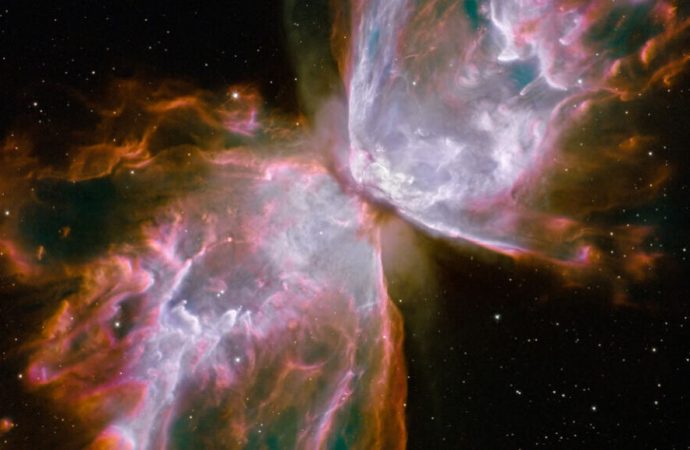Red giant stars reveal that planets or even other stars may influence the shells of gas and dust
Source: Science News
In their dying throes, some stars leave behind beautiful planetary nebulae — disk, spiral or even butterfly-shaped clouds of dust and gas.
How these fantastically shaped clouds arise from round stars is a mystery. New observations of red giant stars suggest that massive planets or other objects orbiting dying stars help stir up stellar winds and shape planetary nebulae, researchers report in the Sept. 18 Science.
“We were wondering how stars can get these beautiful shapes,” says Leen Decin, an astrophysicist at KU Leuven in Belgium. So she and her colleagues examined 14 stars in the red giant phase, before they become planetary nebulae. Data from the Atacama Large Millimeter/submillimeter Array in Chile revealed that stellar winds — fast-moving flows of gas, dust and subatomic particles such as protons — ejected from the red giant stars have different shapes, including spirals, disks and cones.
Mathematical calculations revealed that the mass and orbit of nearby objects, such as planets or another star, could be shaping these stellar winds. The researchers also made 3-D simulations based on the calculations. Stellar wind shapes created in the simulations largely matched those seen in the observations, the team found. The speed of the winds and how quickly a red giant loses mass as it slowly dies also play a role in making those shapes.
Because planetary nebula shapes resemble these winds’ shapes, the researchers conclude that these same forces influence a nebula’s final shape, long before the nebula itself is created. “The action of the shaping does not happen when the star becomes a planetary nebula,” Decin says, but is already happening hundreds of thousands to millions of years before, during the red giant phase. This means that it might be possible to predict the shapes of planetary nebulae long before they form, she says.

Capturing the new images with the same telescope in “great detail and high resolution” gives researchers a way to compare the winds of these dying stars one another, says Quentin Parker, an astrophysicist at the University of Hong Kong. Even when scientists look at different stars, there seem to be some common causes of the various shapes seen in the winds, he says.
Still, there’s sometimes too much time between the red giant phase and the planetary nebula phase to directly connect the two, Parker says. “Although companion objects may indeed play a major role in shaping both red giant winds and planetary nebula,” he says, it doesn’t mean that those stellar winds can always be used for “predicting what the planetary nebula will look like later.”
Source: Science News

































Leave a Comment
You must be logged in to post a comment.